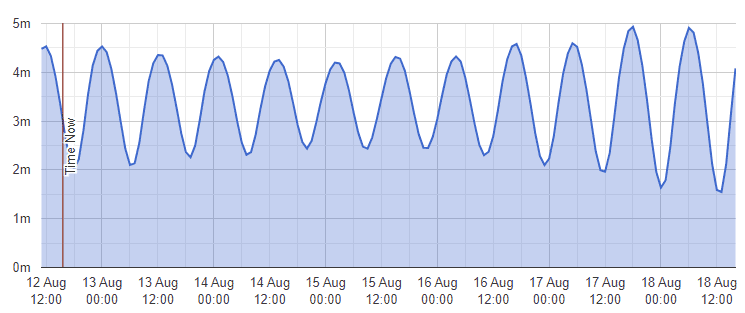The lowest and highest tides
Anyone who has looked at a tide chart closely will have noticed that the height of the high tides (and for that matter low tides) varies over the course of the month. This can also be seen in the graph of tidal heights below.

How big the variation in high and low tide from day to day depends on the location. Spring tides are often more extreme in places with a large tidal range.
Spring Tides
A spring tide is generally a twice-monthly phenomenon in which the high tides are higher than average and low tides lower than average. Despite their name, spring tides are not related to the season of Spring; the term "spring" here comes from the idea of the tide "springing forth" or rising higher.

What causes spring tides?
All tides are the result of the gravitational interaction between the Earth, the Moon, and to a smaller degree, the Sun. The relative movement of these there celestial bodies is what determines not only the times of the tides, but the size of the tide.
In the scheme of things the distances between the the Sun, Moon and Earth is reasonably constant (although it does vary which we will talk about later) and therefore is not the main factor influencing tidal heights.
In simple terms, Spring tides are the result of the alignment of the Sun and the Moon. A linear alignment of the Sun and the Moon, relative to Earth (known as syzygy), effectively combines the gravitational pull on the ocean resulting in greater movement of the tides.
When do spring tides occur?
Spring tides happen whenever there is a full moon or a new moon. That is because this is when the Sun and Moon are aligned; either both on the same side of the Earth (new moon), or on opposite sides (full moon).
The spring tide actually occurs one or two days after the new / full moon. What is interesting though is that spring high and low tides will happen at approximately the same time of the day in a particular location. For example spring high tides on the Solent in the UK are always at around midday and midnight.
Neap Tides
Neap tides are effectively the opposite of spring tides and refer to when there is the smallest difference between high and low tide. This decreased tidal range is the result of the Sun and Moon's gravitational forces working against each other.
Like spring tides, neap tides occur twice a month, but in this case when the Moon is in its first or last quarter. This means the Moon is aligned at roughly a right angle to the Sun in relation to the Earth.
King Tides
A king tide, also known as a perigean spring tide, can be thought of as a spring tide on steroids! These are not just the biggest tides of the month, but the biggest tides of the year. King tides are the highest tides that occur naturally and are not caused by storms or other unusual weather events.

For a tide to be a king tide it requires that not only the Sun, Moon and Earth be in alignment, but for the Moon to be at its closest. Known as perigee, this occurs roughly every 28 days as a result of the Moon's elliptical orbit around the Earth and means the gravitational force of the Moon is at its strongest.
When perigee and a full moon coincide this is commonly referred to as a supermoon, or perigee-syzygy in the scientific world. Occurring three or four times a year supermoons are noticeably bigger and brighter than normal full moons. They also have a stronger gravitational pull on the oceans.
Like spring tides, king tides also occur around new moons. Whilst you won't be able to see the Moon is closer when it is in shadow, it still exerts a stronger pull.
Super Tides?
If king tides are a double whammy of alignment and proximity of the Moon, then super tides are a triple whammy.
During the vernal and autumnal equinox the Sun is positioned directly overhead at the equator. This happens on or around 21st March / September and results in a stronger force on the tides. If this coincides with a closer moon and a full / new moon then we have the conditions for a super tide.
As you might imagine this celestial coincidence is fairly rare, happening only about once every 4 to 5 years. But when it does the highest tides of all occur.
There is another factor that can influence the height of the tide and that is the proximity of the sun. This varies by a few million kilometres throughout the year with the Sun being closest to the Earth around January 2. Called perihelion, the sun's gravitational pull is at its strongest during this time. This cannot occur at the same time as equinox, but either of these conditions act to increase tidal range.